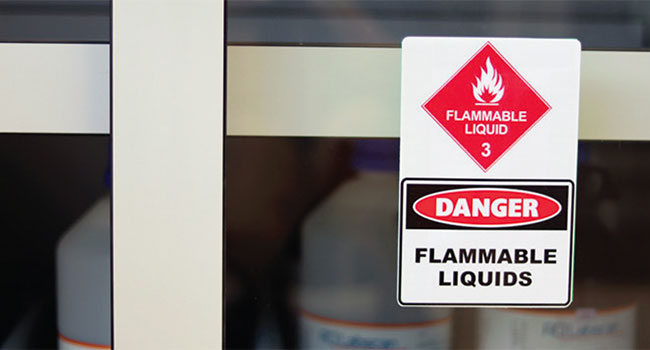
Balancing Fire Safety and COVID Protection
- By Matt Jones
- February 01, 2022
The COVID-19 pandemic has brought a new level of mindfulness to basic hygiene practices. We’ve all become accustomed to washing our hands more frequently, as well as carrying around a bottle of hand sanitizer while we’re on the go. Almost overnight, hand sanitizing stations seem to have popped up everywhere from offices to retail stores to building lobbies to elevators. They’re especially prominent in educational institutions—both K–12 and higher ed—in the name of keeping schools safe, clean and free of infectious diseases.
However, the widespread implementation of hand sanitizing stations requires schools to keep a bulk supply of hand sanitizing liquid available. And finding a safe place to store gallons upon gallons of hand sanitizing fluid is proving to be a logistical nightmare from a fire and life safety inspections perspective.
“Think about what we went through with COVID last year. We didn’t have, in many cases, hand sanitizer stations throughout the buildings. Now, we do. Where is the storage for that hand sanitizer—the bulk storage for that hand sanitizer? Most of that stuff is a flammable or combustible liquid,” said Ralph Bless, Vice President of Account Management for Telgian Corporation. Bless has more than 37 years of experience in fire protection. His specialties include water-based and special hazard system design, fire protection engineering services, and code consulting and review. Bless has offered his services in industries like government, hospitality, retail, convenience, multifamily housing, medical and education—both K–12 and higher ed.
“If we’re carrying more flammable or combustible liquids inside of a building—whether that be a K–12 or higher education—we now may have too much for what that building was originally built for,” Bless continued. “And you won’t then apply the current codes and standards to address how you would keep it, because it’s a change in occupancy. It’s a change in use of that facility. Now, it may only be one room, one storage room, one janitor’s closet, or it may be much larger than that. Even hand sanitizer, using that as an example, there’s a limit on how much you can have in any one place.”
Tom Parrish, Vice President of Integrated Solutions at Telgian and the recently retired Fire Marshal for the Putnam Township Fire Department in Pinckney, Mich., elaborated further.
“That’s one of the issues that we have, is there’s already very strict codes on flammable and combustible liquid storage. And usually, in the gallonage that we’re seeing in normal businesses now, they far exceed the requirements to have a flammable liquid storage cabinet,” Parrish said. “But everybody’s like, ‘Well, we need sanitizer, it’s COVID,’ and I fully understand that. But it is still a Class 1 Flammable. So, we want to make sure that we take care of it and we address that.”
The risk of storing bulk amounts of flammable liquid—especially in, say, a school storage closet alongside a small mountain of printer paper—is fairly self-evident. However, the unique chemical properties of hand sanitizer add an extra layer of danger.
“One of the other issues that you have with the hand sanitizer fires, or with any fires of that class, is generally, that’s an alcohol-based fire,” said Parrish. “So, you’re going to have a very high heat output, but you’re going to have an extremely clean-burning fire—almost possibly to the point that you can’t even see it. You’re going to have what’s burning giving off smoke, but the actual flames—because the alcohol is so pure—cause additional issues, where you may think you’re reaching just to get a piece of paper that’s smoking, and you’re reaching through flames or something like that and not even realizing it.”
The first few months of the pandemic were a chaos of confusion and misinformation, said Bless. Many schools deferred or delayed required safety inspections due to a variety of issues—for example, school employees hesitant to grant inspection teams in-person access to school buildings. Fortunately, fire departments and the National Fire Protection Association (NFPA) clarified that emergency responders had their hands full responding to emergencies, and they couldn’t afford to let systems go without inspection. Bless estimates that about 10% of schools are still lagging on required annual inspections. Even more let weekly or quarterly inspections slide. “You can’t go back in time, so some of those were missed,” he said. “Hopefully we picked up what would have been found, and so there’s no delayed risk increase over that.”
At the end of the day, said Parrish, it’s largely the responsibility of schools themselves to follow regulations. “It’s kinda cliché, but the time spent for an ounce of prevention eliminates a lot of your problems,” he said. “A lot of times, that gets put aside or, you know, ‘We’re not gonna buy a flammable cabinet for our hand sanitizer because this is a short-term issue. We really don’t need it, and it’s not in the budget.’ But, yet, you’ve got 60 gallons of it shoved in a store room, right next to an electrical panel.”
“While we can write code, we can write policies, we can make plans, it is unfortunately—the problem is always the people that will kind of take a short cut,” said Lauris Friedenfelds, Senior Project Manager at Telgian. “Or not abide by a policy because it’s more convenient for them. The times that we’ve had some incidents—minor ones—they were because people didn’t think about the consequences of what they were doing. We had all the codes, all the plans and procedures in place…they never read ‘em.”
This article originally appeared in the January / February 2022 issue of Campus Security Today.